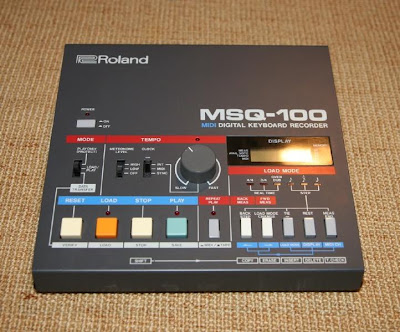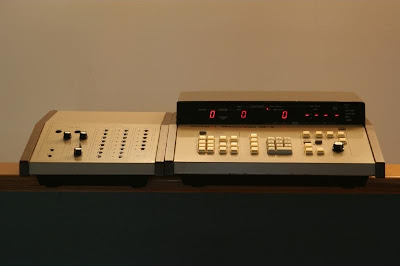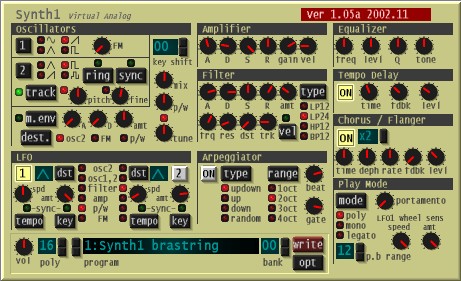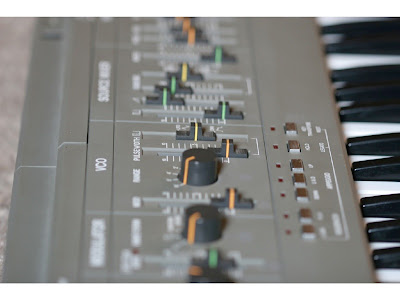
Wednesday, June 06, 2007
Boadicea Enya
YouTube via farnellraptor. Sent my way via Stephen. Roland Juno-60
MOOG Prodigy
 Shot of the inside of a MOOG Prodigy sent my way via Jason.
Shot of the inside of a MOOG Prodigy sent my way via Jason.Support The Synths:
BTW, Jason is participating in Lifehacker.com's Coolest Workspace Contest. Jason is the "Wall of Sound" entry, the only one with synths pictured I might add. Go support the synths!
Museum Technicians - The Underground Series 11/14
YouTube via museumoftechno.
"Well, you can jolly well smack my bitch up, because we've reached episode 11 at long last, wherein we, Mssrs Cornwell and Braidy, bring the elements of our track together into a storming mix which will act as a proper narnie magnet and generally win us ultimate producer propz."
Depech Mode's Puppets by Micah
"In my attempt to get somewhat closer to the arp 2600 sound, I layered the Juno and the Jupiter together for this version of Depeche Mode's Puppets. The juno in my opinion sounds way closer to an american synth then the the Jupiter, but put together you have a synth of a different sort. The drums were done using the juno for the bass drum, and and old korg drum machine sample for the snare. I love that low big sound. This sounds nothing like the orignial puppets but I was just messing around."
Pretty cool. Title link takes you to more by Micah.
Formanta EMS-01

Click here for shots via this auction.
Details:
FORMANTA EMS-01 is an electric music instrument combining a polyphonic organ and a monophonic synthesizer. It is designed to perform music of all genres and to create various sound effects while recording soundtracks for movies and plays, or studio recording. The organ has a 5-octave keyboard, 6 preset sound timbres, frequency vibrato with adjustable vibrato delay, decay adjustment and a stereophaser (common for organ and synthesizer). The "vibrato delay" scheme is activated again only after all the previously pressed keys are released. In the "legato" mode the "vibrato delay" scheme is not activated.
The synthesizer has:
3-octave keyboard;
modulator, modulation voltage from which is applied to frequency modulator, width modulator, filter, and amplifier;
broad band oscillators 1 and 2 (with various waveforms);
mixer, designed for summation of signals from oscillators 1 and 2, noise generator, external source, and ring modulator;
filter, designed for dynamic and static changing of the spectrum of summarized signal from mixer output;
amplifier, designed for making the sound corresponding to various parameters of the envelope;
Visual division of the synthesizer panel into the above listed sections and their lay-out make it more easy to orientate oneself while setting the required timbre. Besides, the synthesizer is able to simultaneously control one more similar synthesizer through a special cable and connectors CONTR IN and CONTR OUT.
The instrument provides the opportunity of connecting stereo headphones; the volume in headphones doesn't change in case of changing the volume of the instrument from zero to maximum at all the outputs of the instrument with the foot pedal; thanks to this, preliminary control of timbre through the headphones before applying it to amplifiers is possible. By switching on PHASER into the channel of organ or synthesizer, it is possible to get stereo sound in the outputs STEREO L and STEREO P. In case PHASER is switched off, both channels will function in MONO mode.
Specifications:
Supply voltage AC 220+10V, 50 Hz;
Power consumption within 75 VA;
Operating conditions: temperature 15-35 C, humidity 65%, barometric pressure 86,6 - 106,6 kPa;
Relative frequency deviation after 4 hours of uninterrupted operation within 0,5%;
5-octave organ keyboard;
Organ band from 43,65 Hz (F controctave) to 1318 Hz (E in three-line octave);
3-octave synthesizer keyboard;
Sound range - 9 octaves;
Adjustment range for organ and synthesizer + 6% (+ 0,5 tone);
Minimal range of continuous detuning of oscillator 2 regarding oscillator 1 - 1 octave;
Range of adjustment of filter cutoff frequency 100- 1500 Hz;
Minimal dynamic range - 55 dB;
Weight within 30 kg.
Sound1
Sound2
Sound3"
Samples mirrored here.
My 263 prototypes
 flickr by verbos2002.
flickr by verbos2002."This is my new creation. The 263 quantizer / shift register. It is a dual 4 stage analog shift register and an 8 channel chromatic quantizer for Buchla systems. The switch in the middle chains to 2 shift registers together for one 8 stage one. These will be available for sale soon, when I get all the bugs out."
Top 10 Synths added to Sticky Posts
Just a heads up. I added the Top 10 Synths Of All Time post to the right, Sticky Posts section.
Doepfer MSY2 MIDI Sync
 via this auction.
via this auction.Details:
"MSY2 is an interface that converts the MIDI realtime events Clock, Start and Stop into the corresponding signals Clock and Start/Stop of the SYNC standard. This standard was used e.g. in the Roland devices TB303 bass line or TR808 rhythm composer.
MSY2 is equipped with 2 SYNC DIN sockets (switched in parallel), a Clock miniature jack socket (3.5mm), MIDI-in and MIDI-Thru. SYNC-CLOCK is a periodic signal (0/+5V) representing the tempo. SYNC-START/STOP is a signal that indicates one of the 2 possible states: START = +5V, STOP = 0V. The Clock pin of the SYNC standard is additionally available from a miniature jack socket e.g. for synchronizing the arpeggio input of an analog synthesizer with MIDI.
 MSY2 enables the 1:1 conversion of MIDI CLOCK to SYNC CLOCK (i.e. 1 MIDI clock triggers 1 SYNC clock pulse), as well as the reduction of the tempo by dividing the incoming MIDI clock frequency by an integer factor. The factor can be set to any value between 1 and 16 with a DIP switch at the bottom of the MSY2. A factor 1 corresponds to the 1:1 conversion, 16 is the maximum of frequency reduction, i.e. after 16 MIDI clocks 1 SYNC clock appears.
MSY2 enables the 1:1 conversion of MIDI CLOCK to SYNC CLOCK (i.e. 1 MIDI clock triggers 1 SYNC clock pulse), as well as the reduction of the tempo by dividing the incoming MIDI clock frequency by an integer factor. The factor can be set to any value between 1 and 16 with a DIP switch at the bottom of the MSY2. A factor 1 corresponds to the 1:1 conversion, 16 is the maximum of frequency reduction, i.e. after 16 MIDI clocks 1 SYNC clock appears.With two other switches the Start/Stop polarity and the Clock polarity can be changed for special applications not following the SYNC standard.
Clock and Start/Stop are displayed with 2 LEDs.
MIDI-In, MIDI-Thru"
Roland MSQ-100
 via this auction.
via this auction.Details:
"Many current MSQ-100 users use it as a MIDI-to-sync converter for the popular Roland TB-303, TR-909 and TR-808. I used mine to sync two Frostwave Fat Controller analog sequencers as seen in the embedded video. Then, if I wanted to sync to my DAW, I flipped a single switch on the MSQ-100 and now they're locked to external MIDI clock. "

Roland MC-8

Update via Chris Carter in the comments:
"I owned an MC8 from 1982 to 2002 and used it on many recording (I bought it from Landscape, who recorded 'Einstein agogo' with it). An article I wrote about the MC8 can be found here."
Click here for shots via this auction.
Details:
"This is the Roland MC-8 MicroComposer. They called it a MicroComposer due to its diminutive foot print. Actually, that isn't true. It was designated as the MicroComposer as it was the first microprocessor controlled sequencer - the Intel 8080, to be precise. In addition to launching the 'MC' moniker, it also introduced other innovative features like copy and paste.
So, if you were an electronic musician in 1977, you could drop $8000 and string together 1000 or so notes with Japanese precision.
 The MC8 provides eight channels of CV and gate outputs for controlling inputs found on synthesizers from Moog, Roland, Arp and others. I used this with a Doepfer A-100 modular, Prophet 5, minimoog and SH-101. There is no MIDI, this is all about a microprocessor coupled as directly as possible to analog voltage outputs.
The MC8 provides eight channels of CV and gate outputs for controlling inputs found on synthesizers from Moog, Roland, Arp and others. I used this with a Doepfer A-100 modular, Prophet 5, minimoog and SH-101. There is no MIDI, this is all about a microprocessor coupled as directly as possible to analog voltage outputs.If you're sequencing drums, you don't have to waste the normal CV outputs (and consume memory with unnecessary note data) by using the additional MPX outputs. You can even automate tempo and the presence of portamento. Or, you could use the MPX outputs in conjunction with a sequential switch to control which of several envelopes are used for a particular phrase. They were clearly thinking of serious, complete automation here.
Controlling it all is an impressive console that looks as if it were responsible for launching ICBMs. It certainly feels that way as all the controls and switches seem designed to withstand a nuclear blast. It worked, too. 30 years later, this machine still works great. If you're at all familiar with a 10-key keypad, you can enter data in by touch, without even looking at the unit. The response of the keypad is delightfully retro and a joy to use. All the buttons have satisfying physical feedback that seems absent on current gear.
The MC-8 was expensive for Roland to build, though. It is reported only 200 left the factory. This is a rare chance to own a unique piece of Roland history. I'm selling this and other items because my work area needs to occupy a smaller space.
Famous users of the MC-8 are reported to include: Kraftwerk, Human League (Dare), Tangerine Dream, Hans Zimmer, Toto, and Tomita.
Included in the auction is the original factory manual, interface cable, CV interface unit and, of course, the MC-8 itself."

Sequential Circuits Pro One
YouTube via stretta.
"Running through the various functions of the Pro One. Not a keyboard wankery video, or musical statement. Created for an ebay auction."
Doepfer MAQ 16/3
YouTube via stretta.
"A short test of the Doepfer MAQ 16/3. Not a musical statement. Created for an ebay auction.
Fat Controllers and Voyager
YouTube via stretta.
"This is a demonstration of the Frostwave Fat Controller, not a keyboard wankery video, or a musical statement. Created for an ebay auction." Images saved here.
Roland SH-101
YouTube via stretta.
"A test of the functions of the Roland SH-101. Not a keyboard wankery video or musical statement. Created for an ebay auction."
Morton Subotnick Dancing with Robots
 Title link takes you to the post on Street Electronics. Click on the images for video when you get there. BTW, do check out the rest of Street Electronics when you get there. You will find tons of synth content.
Title link takes you to the post on Street Electronics. Click on the images for video when you get there. BTW, do check out the rest of Street Electronics when you get there. You will find tons of synth content.
Haus Elektronik Prototype Drum Machine
YouTube via deltalabstudios. Sent my way via Delta Lab Recording Studios, and on MySpace.
"Very rare prototype Drum Machine Synth"
Update: A little more info: "i got it on ebay about a year ago. i only used a couple of times. he got it from he's father who build and designed it. as you can hear, it sounds hot! it's got inputs for each sound CV gate and and l-r outpout"
SECTOR101 SYEMB06 ReBirth Project
 "The SYEMB06 ReBirth Project came about through a thread on the YamahaForums website about making a batch of SYEMB06 Non-Volatile Memory clones.
"The SYEMB06 ReBirth Project came about through a thread on the YamahaForums website about making a batch of SYEMB06 Non-Volatile Memory clones.After much information gathering and several prototypes a batch of 60 clone modules have been assembled and tested.
This module will take the place of the long discontinued and now very rare Yamaha SYEMB06 512KB non-volatile module. The Yamaha synths that can use this sample memory upgrade module are the SY85, TG500 and RM50.
These modules are now available for sale - please see the Purchase page for details on how to buy modules for your SY85 / TG500 / RM50 right here from this website."
via altemark.
Oakley Sounds Equinoxe: Voltage Controlled Phaser Module
 "This is our hugely popular version of the classic four stage OTA based phaser. Wonderfully lush and smooth, its similar in sound to the phaser used by Jean Michel Jarre on Oxygene and Equinoxe albums.
"This is our hugely popular version of the classic four stage OTA based phaser. Wonderfully lush and smooth, its similar in sound to the phaser used by Jean Michel Jarre on Oxygene and Equinoxe albums.The unit includes a useful internal low frequency oscillator with accompanying bicolour LED. The centre frequency of the phase shifter can also be controlled by an external control voltage. Thus allowing envelope generators to be used to sweep the phaser to create filter type effects.
The PCB is laid out to accept four high quality Spectrol pots:
Frequency: this controls the frequency of the two notches created by the phase shift network.
Emphasis: this accentuates the feedback signal within the phaser to create a deeper effect.
Modulation: A simple attenuator to adjust the level of the internal LFO or incoming CV.
LFO rate: adjusts the speed of the LFO.
The internal LFO produces a triangle wave output which is also available from a front panel socket. This allows you to use the internal LFO for other modulation purposes. The LFO signal is automatically routed to the modulation depth pot when no jack is inserted in the CV input. The new issue board allows a choice of inverted or non-inverted waveforms. Thus two Equinoxe units can be used for stereo phase panning.
The unit is designed to work with standard MOTM/Oakley signal levels, although it could be easily converted to be driven from other sources including an electric guitar.
This unit is also made by us, in small format, as the RS400 Phaser for the Analogue Systems' Integrator modular."
Title link takes you there. Samples on site.
YMO Rydeen Cover on Synth1

Click here for a pretty amazing cover of YMO's Rydeen done with Ichiro Toda's free VST Synth1. Scroll down for the link when you get there. You can get the VST here.
via Elhardt on AH.
PREVIOUS PAGE
NEXT PAGE
HOME













© Matrixsynth - All posts are presented here for informative, historical and educative purposes as applicable within fair use.
MATRIXSYNTH is supported by affiliate links that use cookies to track clickthroughs and sales. See the privacy policy for details.
MATRIXSYNTH - EVERYTHING SYNTH













© Matrixsynth - All posts are presented here for informative, historical and educative purposes as applicable within fair use.
MATRIXSYNTH is supported by affiliate links that use cookies to track clickthroughs and sales. See the privacy policy for details.
MATRIXSYNTH - EVERYTHING SYNTH






























